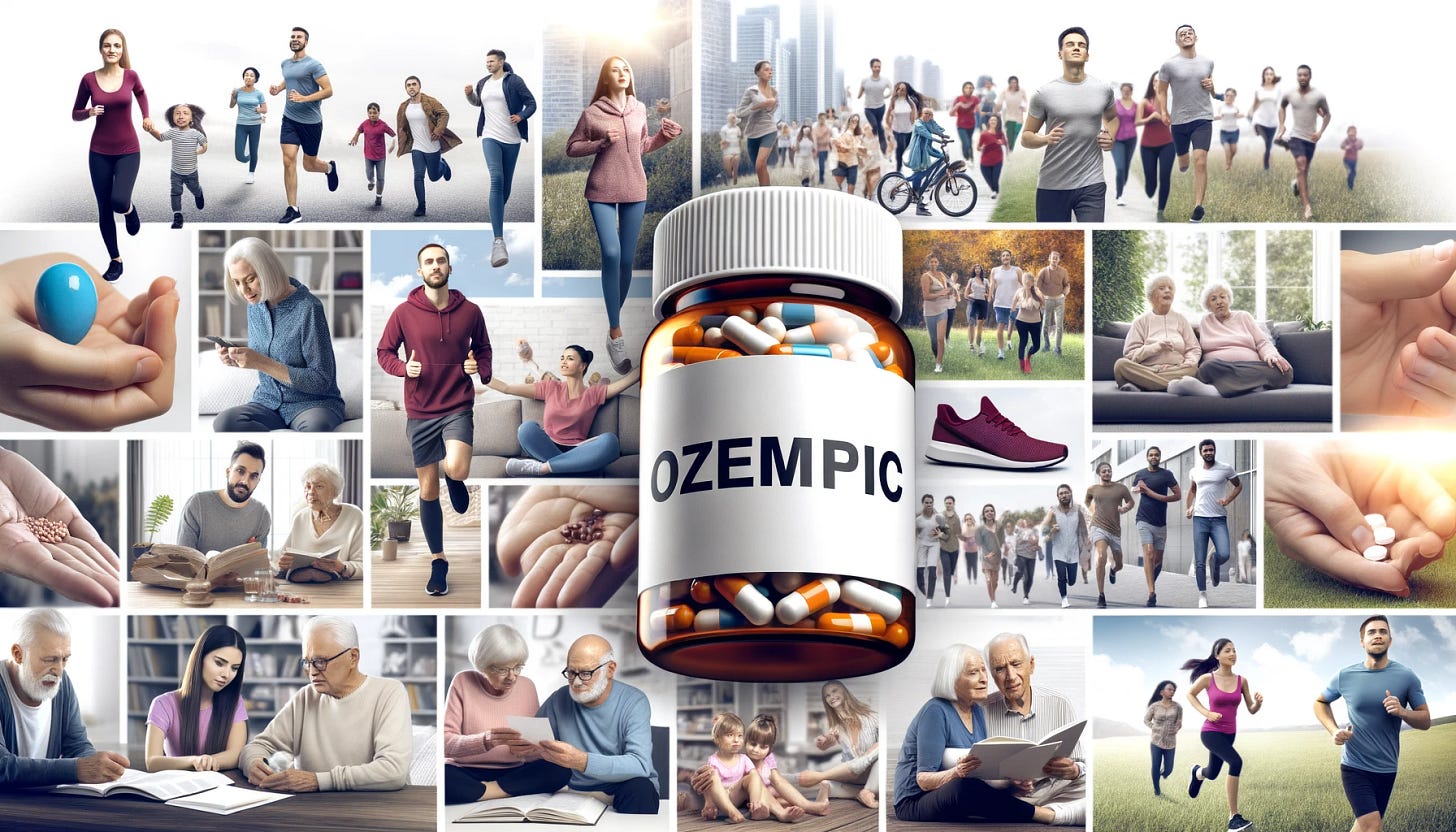Today’s post, while related to the long term vs short term thinking I often write about in Marketing BS, drifts pretty far from marketing. But I think it is about as an important topic as there is for almost everyone, and I think I have some valuable perspectives to share — maybe more valuable for your life than how to increase your conversion rate. The essay starts with what we know about Ozempic, and then explores two other tools I am using that I believe will have significant impact on my healthy lifespan. There is a lot in this essay! It’s over 3000 words and there was still a lot I did not cover. If there is interest I could do an AMA for paying subscribers. Just make a comment on the post if that would be something you would be interested in. I hope you enjoy the change of pace (I have also given a preview of the Ozempic stuff for non-subscribers. The rest I am keeping behind the paywall for what will be obvious reasons for those who get that far).

Tuesday’s post was about Twitter’s Community Notes on advertisements. In it I argued that the impact of allowing Notes on advertisements may be negative in the short term (losing $40MM of direct advertising RIGHT NOW), but positive in the long term (more trusted ads and advertisers, more users engaged with ads). The challenge for companies that care about the long term health of their business is that it is much more difficult to measure the long term impact of decisions than it is to measure the short term impact.
When it comes to individuals that is very little that is more “long term” than healthy life extension.
Last Thursday I wrote about the business implications of Ozempic. Everyone seems to be talking about it now. In addition to the weight loss impact the drug has been shown to reduce the risk of heart attacks and stroked by 20%, and have extremely positive impact on the liver and kidneys. The kidney results were so impressive that when they were announced on October 10th shares of publicly traded dialysis companies Fresenius Medical Care AG and DaVita Inc both dropped by 20%.
There is also the possibility, alluded to in last week’s essay, that the drug may improve impulse control more broadly. The NYTs writes about how users sometimes lose the desire to drink. Some quotes from the article:
“…doctors say that many patients are reporting similar experiences: They start the medication and then stop wanting to drink alcohol.”
…She found herself “repelled” by alcohol, she said. She would try to have a drink but struggled to finish. “It was like, ugh, I don’t want to,” she said.
“Even some people who drank moderately before starting Ozempic find themselves avoiding alcohol… three months after going on Ozempic, he stopped buying alcohol except for when he ate out. He used to have two beers with dinner — one when he first sat down, one about midway through the meal — but now, he said, he can barely sip through the first one.”
From personal experience, I started my usage of the drug last Sunday. Last night I went out with some friends to a brewery. I shared a flight of IPA with my wife (And enjoyed it!) and then ordered an addition pint to share with her. I drank less than half of that pint and felt no desire to finish it. While I do not drink very often these days, leaving half a pint of good beer unfinished is not a behavior I have normally engaged in. I don’t know if it was the drug, but it definitely wasn’t natural will power. And I am still on the lowest dose.
Researchers now believe that the drug also reduces risk of Alzheimer’s and Parkinson’s disease. Trials are underway and results are expected sometime in 2026.
Another Doctor believes it reduces other dopamine-fueled behaviors like “shopping”.
But I don’t expect an FDA-caliber trial to determine if that is true.
Ozempic was discovered in 2012. Clinical trials began in 2016. In 2017 it was finally available for doctors to prescribe. Only recently, six years later, has it become the best selling drug in America — and still less than 2% of adults are taking it (73.1% of US adults are overweight or more; 9.2% are “severely obese”). The drug is currently only recommended for people who are obese (42.4% of adults), but I expect it would be valuable for a lot more people than that. It just hasn’t been fulling TESTED on people who are thinner than obese. But it is not like a BMI of 30.0 is a magic number that is substantially different than BMI of 29.9.
More and more data suggests this is a “wonder drug” and may dramatically improve the lifespan of most Americans who take it. And yet it has taken 11 years to become popular, and is still used by only a small fraction of those that would benefit. AND the drug has a very obvious and significant short term impact of making the user lose weight — in a weight-obsessed society.
Imagine if Semaglutide had all the positive impacts it seems to have on health, but did not make you skinnier. How many people do you think would be using it? Imagine if it increased lifespan and reduced stroke, heart disease, Alzheimer’s and Parkinson’s disease but you needed to take it for about a decade before it had that impact. How would we know? We definitely would not have the patience to run decade-long trials. Even if they were robust enough to get the results we needed, the drug would be off patent before it saw any significant sales — assume short-term thinking Americans would even buy a drug that extended their lifespan that they needed to start taking in middle age. People still smoke cigarettes!
My point is, is that if we invented a drug that could make you live forever I expect most people would not take it, the medical establishment would not recommend it, and no clinical trials would be done on it. It would need to have some obvious measurable short-term impacts to get any sort of traction. Maybe after some ultra-wealthy, risk-taking, people started taking it for extended periods of time and started living past their centennial, it would start to catch on with younger people. Which means if the drug was invented today, it might start to catch on around 2070 when Elon Musk hit his late 90s and seemed to be in good health.
Realistically we are not going to have an immortality drug today. Any lifespan-improvement drugs are likely to be incremental — which makes them even less likely to spread through the population.
My Plan to Live Longer
My fourth child was born when I was 45.5 years old. If he waits that long to have his last kid I will be 91 years old when my final grand kid is born. This life expectancy calculator gives me a 50% chance of living to 94 years old. So I have a pretty good chance of seeing all my grand kids born. But not the odds I would like to have.
I have spent the last six months looking into ways I can extend my life. Semaglutide is one prong of that tool kit (for those interested it is not easy to get right now. My doctor told me he thought he could get insurance coverage, but no pharmacy in Seattle had drug available to distribute. I managed to get it through the VITAstir Clinic. That meant no insurance coverage, but they had a 50% off sale on the first two months doses. that still meant $400/month, but its a lot better than the $1100/month being changed at my local CVS).
In addition to Semaglutide there are two more significant tools I have added to my toolkit.
Keep reading with a 7-day free trial
Subscribe to Marketing BS with Edward Nevraumont to keep reading this post and get 7 days of free access to the full post archives.




